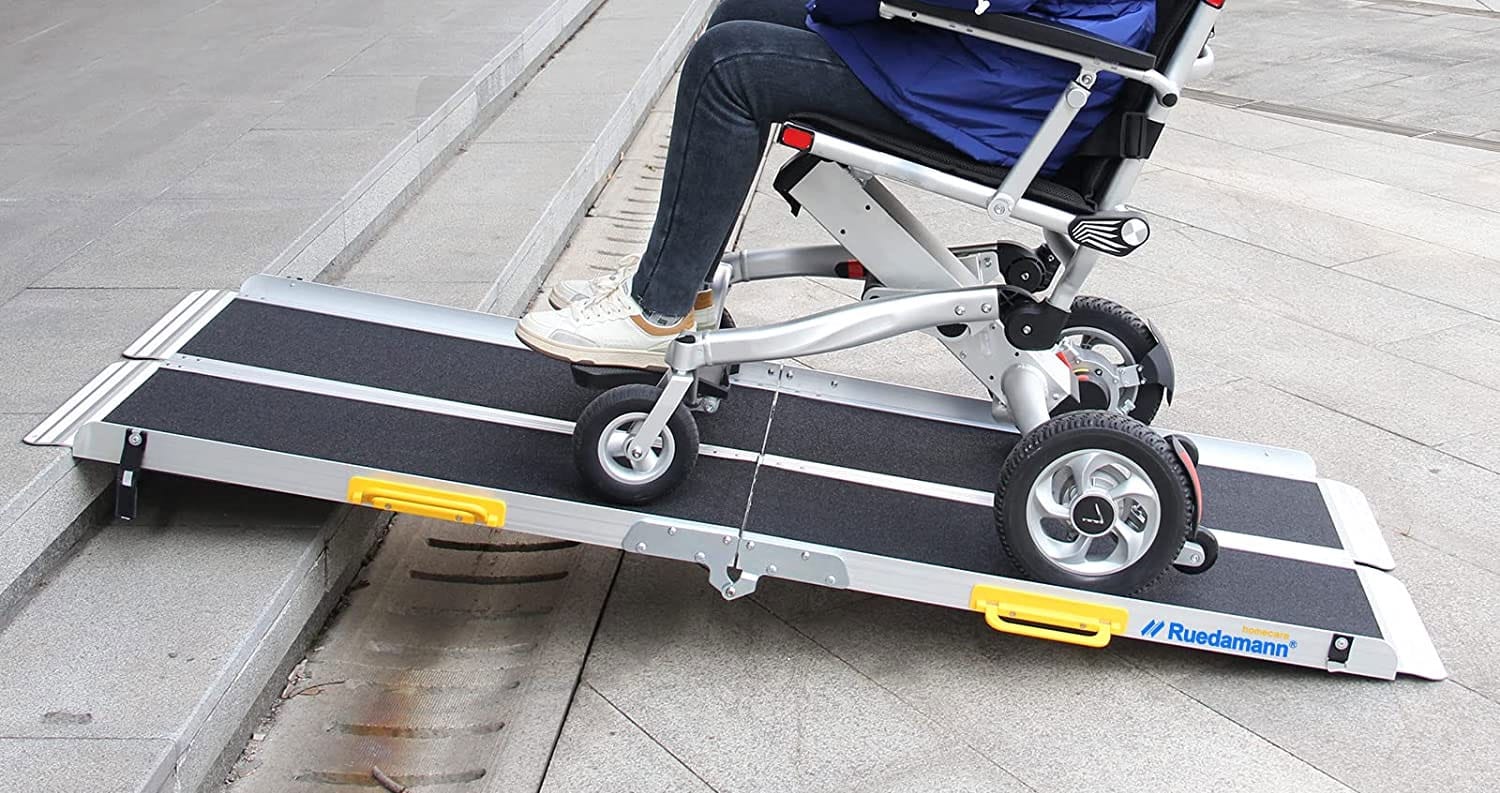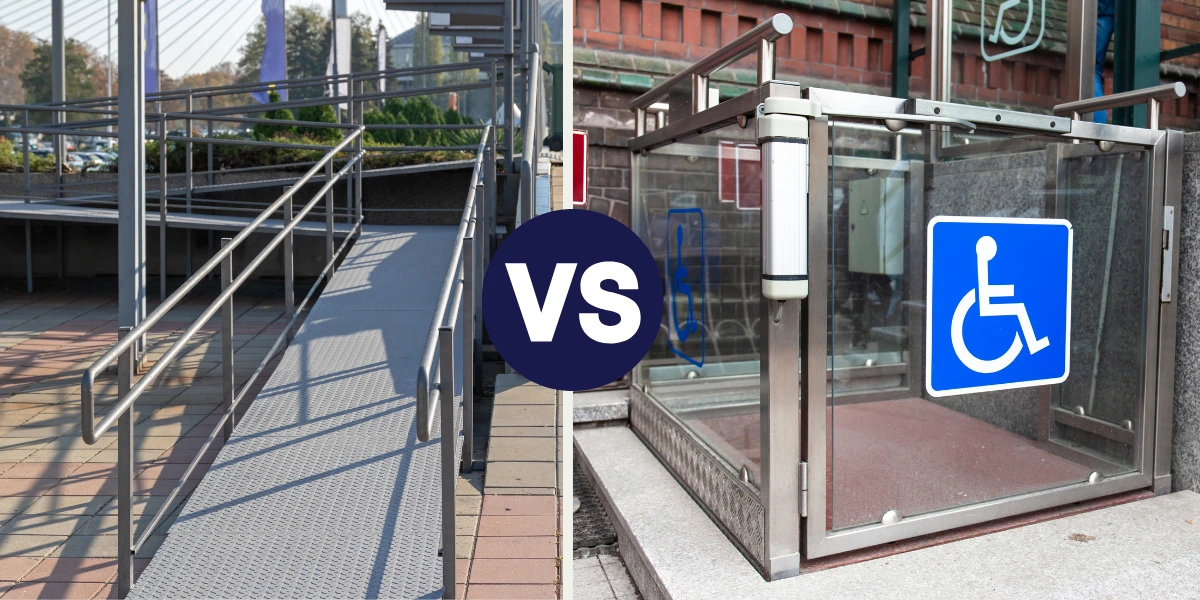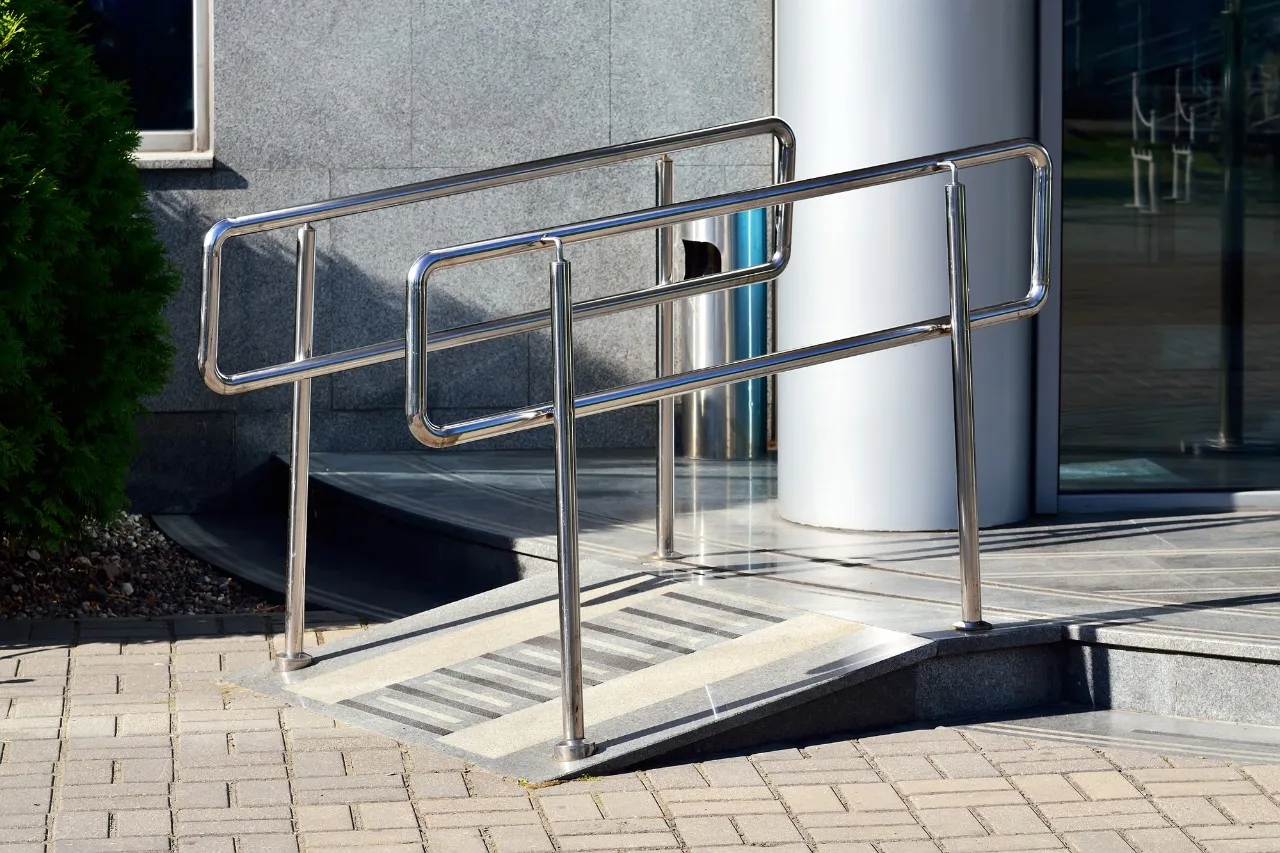If you’ve ever tried pushing a wheelchair over a step that feels like Mount Everest, you already know why ramps matter. And if you’re...
How to Choose the Right Disability Ramp for Melbourne Home
Imagine a Melbourne terrace party where one of your guests rolls in on wheels – they should glide up the front porch in style, not struggle with a step. That’s where the right disability ramp comes in: it’s the red carpet for wheelchair and scooter users.
A well-chosen ramp blends seamlessly with your home’s look while ensuring safety and independence. In fact, aids like wheelchairs and ramps “can help you live at home and participate in the community”. We’ll dive into what matters when picking a ramp – from style and standards to handy products – so your home is both trendy and accessible.
Why a Ramp Matters
Let’s be honest: mobility ramps aren’t just functional; they’re life-changers. A ramp can be the difference between feeling stuck at home and joining family events easily. In Victoria, the State-wide Equipment Program (SWEP) explicitly includes ramps for walking and wheelchair access as subsidised equipment. This shows ramps are essential aids – like wheelchairs or walking frames – that support everyday living.
- Independence: A ramp means you (or a loved one) can come and go without help, boosting confidence and freedom.
- Safety: Smooth, non-slip surfaces and handrails reduce fall risks. For example, many quality ramps come with textured, anti-slip coatings so “there’s no problem with becoming wet outside” – great for Melbourne’s rainy days.
- Inclusivity: Visually and practically, a well-designed ramp turns your home into a welcoming space for everyone. With thoughtful design, it can even enhance your curb appeal instead of looking like an afterthought.
Types of Home Ramps
Ramps come in all shapes and styles. Melbourne homeowners often choose based on the entry height, space, and whether they rent or own. Here are the main types:
Threshold (Wedge) Ramps:
These small ramps (often rubber or plastic) fit under a doorway sill or one step. They’re only a few centimetres high – think of a gentle wedge – and cost as low as $100–$300. Rubber threshold ramps (like Heeve’s models) are very durable and weather-resistant. In fact, “recycled rubber threshold ramps… made from recycled truck tyres” exist, and solid rubber versions can support up to 400 kg. Plastic thresholds are lighter and cheaper, yet still hold up to ~300 kg. Insert image of a compact rubber threshold ramp in a doorway. These are discreet (some homeowners even match them to patio tiles) and great for quick fixes.
Portable (Foldable) Ramps:
Need flexibility? Portable ramps are like the Swiss Army knives of accessibility. Usually aluminium or composite, they fold, telescope, or roll up for storage. Picture pulling out a neat suitcase-ramp when your cousin visits, then tucking it away. In Melbourne, a 2m heavy-duty telescoping ramp might cost $300–$400. According to MobilityCare, “aluminium construction ensures they’re lightweight, strong and portable”, making assembly and pack-up easy. Importantly, all our picks have anti-slip surfaces, so a little rain won’t send anyone skidding. “Our range… includes threshold, solid, single-fold, multi-fold, [and even] side rail options”. For example, MobilityCare offers a PVI Singlefold Ramp from around $365 and a PVI Threshold Ramp for about $149. These let renters or travellers bring accessibility with them wherever they go.
Modular (Prefabricated) Ramps:
These are DIY-friendly kits made of aluminium sections. Imagine Lego pieces of ramp: 1.2m or 1.5m modules bolt together to cover your entry. They often look sleek and industrial – some come powder-coated in cool colors. Melbourne guides show basic kits cost about $850–$950 per metre (without railings). You can then add rails (~$350 per side per metre) for safety. Because they’re pre-made, installation is quicker and you get a uniformly solid structure. Visualize a modern house with a straight aluminium ramp and minimalist glass or steel balustrades – that’s on-trend in Melbourne’s design scene.
Permanent (Custom) Ramps:
For a built-in, one-off solution, think timber or concrete. A custom ramp can become part of your deck or porch. It might be a timber frame with composite decking, stained to match your floors; or a concrete ramp paved with tiles. These are usually done by professionals (safety first!), so costs jump – around $1,600–$1,800 per metre including installation. A 3m timber ramp could be $5,000+ with landings. The payoff? It looks polished and permanent. You can even use designer touches (like matte-black rails or integrated lighting) so it feels like part of a modern home. One homeowner’s ramp was styled with natural wood and metal – “like art,” really.



Key Factors for Your Choice
So, how do you pick? Here are the big factors:
Height and Slope:
Measure the rise (the height from ground to doorway). Then calculate ramp length: the gentle AS 1428.1 standard prefers a 1:14 slope (1 m up for 14 m long) for ramps over ~2 m. Shorter ramps can be steeper (up to ~1:10). In practice, longer means shallower, so check this first. If space is tight, portable or shorter solutions (like a threshold ramp) might work, whereas bigger rises often need longer, built-in ramps with landings.
Width:
A standard wheelchair needs about 1 m of clear width. AS 1428.1 actually requires at least 1,000 mm between handrails. Many designers go wider (1.2–1.5 m) so two people can pass or a wheelchair can turn. For a residential entry, 1m–1.2m is usually fine. Portable ramps come in standard widths (often ~70cm wide), just make sure it fits your device.
Weight Capacity:
Check the ramp’s load limit. Most personal-use ramps are rated 200–300 kg (folded wheelchair plus user). Heavier-duty versions (like steel ramps) go up to 450–800 kg. If you have a heavy power chair or regularly use a mobility scooter, aim higher. For example, some rubber threshold ramps and modular kits can handle 400–500 kg. RampChamp’s Heeve Solid Rubber threshold ramp holds up to 400 kg, so it’s a good sturdy choice.
Material & Durability:
Outdoors, choose weather-proof materials. Rubber and plastic ramps won’t rust – good for Melbourne’s rain. Rubber is heavy but rock-solid, plastic is light and cheap. Aluminium (in portable/modular ramps) is strong and rust-resistant. Wood (in custom ramps) looks great but needs maintenance (sealing, etc.). Think about longevity: rubber ramps are “built to last” and even trim to size if needed. If you’re on a budget, rubber/plastic for small rises or aluminium kits for medium rises balance cost and quality nicely.
Installation & Flexibility:
Decide if you want a permanent fixture or something temporary. Fixed ramps need planning (and often a council permit) but feel seamless. Portable ramps are instant and moveable. If you’re renting or might redecorate, a non-permanent ramp is smart – you can take it with you or store it. Permanent ramps might require stairs to be rebuilt or decks to be extended (and yes, most Melbourne councils will want your ramp to meet AS 1428.1 and building code).
Safety Features:
Look for rails (especially on permanent or longer ramps), raised edges (to stop wheels slipping off), and textured surfaces. Many ramps now come with built-in traction treads. For instance, MobilityCare notes that “any choice you go for comes equipped with an anti-slip, high traction, water resistant surface”. Handrails at 90–100 cm height (as per AS 1428.1) are wise if the ramp is long or steep. Even a short threshold ramp often has little winged edges to prevent shunts – clever design for safety.
Aesthetic and Home Style:
In Melbourne’s trendy homes, you don’t have to sacrifice looks. Some ramps mimic deck styles (e.g. timber with glass balustrades) or use colorful metal that matches your fence. Think of your ramp as an architectural feature: a timber deck ramp can feel like an extra porch rather than an “accessory.” On the flip side, bright yellow safety rails can also signal “hey, this is a purposeful addition.” Match the material and color to your entryway. For example, natural Merbau wood is popular on Victorian porches, while sleek steel with glass fits contemporary lofts.
Practical Tips & Checklist
- Measure Carefully: Note the total rise (in millimetres) you need to cover. Don’t forget any lip or weather strip.
- Check Standards: AS 1428.1 is our guide. Generally keep ramps no steeper than 1:14 for long runs. Make sure the final product will handle your wheelchair width and weight.
- Material Choice: For outdoor long-term use, rust-proof is key. Rubber and polyethylene plastics resist weather, while aluminum is lightweight and strong. For cool curb appeal, wood decks look great – just factor maintenance.
- Slip-Resistance: Always pick a ramp with textured or grooved surfaces. Wet Melbourne winters make this non-negotiable.
- Permit & Approvals: If the ramp is permanent, check with your local council before installation. Most will require compliance with AS 1428 and building codes (even trendy inner-city suburbs like Fitzroy or Southbank). A quick call can save headaches. Temporary ramps usually don’t need permits.
- Plan for the Future: Melbourne’s building regs now push step-free entries for new homes. If you might sell or rebuild later, investing in a sturdy ramp now is “future-proofing” your place.
Ramp Selection Table
| Ramp Type | Typical Material/Description | Price (Melbourne) | Best Use |
|---|---|---|---|
| Threshold Ramp | Rubber or plastic wedge (15–75 mm high) | ~$100–$300 | Small step/doorway (under 1 step) |
| Portable Ramp | Folding/telescoping aluminum or composite | ~$300–$1,000 (e.g. 2m telescoping ~$300) | Occasional use, travel, renters |
| Modular Ramp | Prefab aluminum kit sections (1–2 m modules) | ~$850–$950/m (basic, rails +$350/m) | DIY assembly, medium rises |
| Permanent Ramp | Timber frame with decking or poured concrete | ~$1,600–$1,800/m (incl. install); landings +$1,200/m² | Long-term, large height differences, custom designs |
Source: Vitalease (2025) comparison of ramp costs in Melbourne.
This table gives ballpark figures. For example, a heavy-duty timber deck ramp (3 m with rails) might run ~$5,000, whereas a similar-length aluminium kit could be ~$2,600. Always get local quotes and consider if NDIS or Victorian aid programs (like the State-wide Equipment Program) can help cover costs.
Featured Ramp Products
To make this concrete, here are some examples you might find on Australian ramp suppliers:
- Heeve Solid Rubber Threshold Ramp (Winged Edges): A durable recycled-rubber wedge, great for doorways. Supports up to 400 kg. RampChamp offers this for about $59 (bargain!). Its winged edges help wheelchairs transition smoothly without snagging.
- Heeve Recycled Rubber Threshold Ramp: Similar to above but made from 100% recycled truck tyres. It’s versatile (available in different heights) and eco-friendly. A stylish, modern home can blend this into a small step area for an almost invisible fix.
- PVI Ontrac Solid Ramp: A premium portable ramp (solid aluminium), sold by MobilityCare for about $1,645. It’s heavy-duty (often used for car entries too) and has high load capacity. Ideal if you want a one-piece, very strong ramp that you might move less often.
- PVI Multifold Ramp: Folding aluminum ramp (about 4 sections) from MobilityCare, ~2–3 m long, around $860. It telescopes or folds into a compact bundle for storage. Handy for doorways or small patios, yet long enough to handle a moderate step (like 20–30 cm).
- PVI Threshold Ramp (Plastic): A simple HDPE plastic ramp from MobilityCare for ~$149. Good for small door steps (often comes with optional side flaps). It’s super light – you can pick it up one-handed – and slip-resistant. Useful as a spare or temporary solution.
- Invacare Edge Barrier: Not exactly a ramp, but this is a clip-on curb/edge piece (~$630) that helps secure rolled mats or ramps in place. You might see it used on low porch edges.
When picking a specific product, check dimensions and load rating closely. Also, use these supplier sites (RampChamp, MobilityCare, etc.) to compare user reviews and exact specs.
Choosing Wisely – Checklist
- Assess Your Entry: How many steps or how high is the lip? This decides ramp type and length needed.
- Portability vs Permanence: Do you move often? Portable might be best. A homeowner planning to stay might prefer a fixed deck ramp.
- Budget & Funding: If you qualify, NDIS may fund ramps as “reasonable and necessary” home mods (especially if you or a family member is a participant). Check Better Health Victoria’s fact sheet and the NDIS website for guidance. Otherwise, weigh upfront cost vs long-term value (see table above).
- Local Climate: Melbourne gets wet and sometimes icy winters. Prioritize non-slip surfaces and drainage under the ramp. Rubber and treaded aluminium can handle moisture well.
- Future-Proofing: With step-free entry now a requirement for new builds, adding a ramp can actually increase your home’s market appeal. And you’ll never have to worry if mobility needs change down the track.
Conclusion
Choosing the right disability ramp for your Melbourne home is a blend of practicality and style. You want a ramp that meets technical needs (proper slope, strength and safety) but also fits your life (look, budget, permanence). By thinking through your needs, local regulations, and even design trends, you can find a ramp that looks like it was always meant to be there.
Remember: ramps aren’t just a functional necessity; they can boost inclusivity and curb appeal. In Melbourne’s design-conscious scene, your ramp can be just as sleek or natural-looking as any other home improvement. Whether you go with a rubber threshold wedge for subtlety, a slick portable kit for flexibility, or a custom timber deck ramp for lasting flair, the right choice will make daily life smoother for everyone in your household.
If you have more questions or a cool ramp story, drop a line below! We love hearing how folks make their homes both accessible and beautiful. And if you’re getting started, don’t forget to check out resources like the Better Health Victoria fact sheet on aids and equipment for info on funding and support.
FAQs
Do I need council approval to install a disability ramp at my Melbourne home?
Yes, if you’re installing a permanent ramp outside your home, you’ll likely need a building permit and must comply with the Australian Standard AS 1428.1 and your local council’s building regulations. Temporary or portable ramps usually don’t require approval, but it’s smart to double-check with your local council.
What is the ideal slope for a residential disability ramp?
According to AS 1428.1, the recommended maximum gradient for residential ramps is 1:14 (for every 1 metre in height, you’ll need 14 metres in length). For shorter ramps (less than 1.9 metres long), steeper gradients like 1:10 are sometimes allowed, but shallower is always safer and easier to use.
Can I use a portable disability ramp both indoors and outdoors?
Absolutely! Portable ramps, especially those made from aluminium or durable plastic, are designed for both indoor and outdoor use. Just make sure the ramp has an anti-slip surface and is weather-resistant, which is essential for Melbourne’s rainy climate.
Are there financial assistance options for buying a disability ramp in Victoria?
Yes, eligible residents may access funding through programs like the NDIS (National Disability Insurance Scheme) or Victoria’s State-wide Equipment Program (SWEP). These programs can help cover the cost of disability ramps if they’re deemed necessary for daily living.




